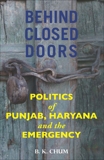
Behind Closed Doors: Politics of Punjab, Haryana and the Emergency |
|
|---|---|
| Authors: | Chum, B. K. |
| Publisher: | Hay House |
| BISAC/Subject: | POL054000, POL046000 |
| ISBN: | 9789381398623, Related ISBNs: 9381398623, 9789381398623 |
| Classification: | Non-Fiction |
| Number of pages: | 364, |
| Audience: | General/trade |
Synopsis: A riveting volume that paints politics and politicians in their true colours!
A candid, hard-hitting and incisive work that throws light on crucial events in post-independence India – focusing on Punjab, Haryana and the Emergency – that had serious repercussions for the nation . . .
As a seasoned journalist, B. K. Chum, who was a witness to history-in-the-making for more than six decades, has gone ‘behind closed doors’ to unearth secrets that politicians prefer to keep hidden.
Beginning with Punjab in the early 1950s, when the Akalis demanded a separate Punjabi-speaking state, Chum recounts how the resultant turmoil led to the state being split on the basis of language. He moves on to describe the terrorism years, which had disastrous consequences for the nation. In the process, he reveals how an unholy nexus between the Congress leader Giani Zail Singh and the Sikh preacher-turned-extremist Jarnail Singh Bhindranwale, to counter the Akalis, led to indiscriminate killings and widespread bloodshed and also to the marginalization of the moderate Akalis such as Sant Harchand Singh Longowal, Parkash Singh Badal and Surjit Singh Barnala. Chum details how the extremists took control of the Golden Temple at Amritsar, necessitating Operation Bluestar, which resulted in the subsequent assassination of Prime Minister Indira Gandhi. He details the efforts made to root out terrorism and how it was eventually wiped out after Beant Singh, who took over as Punjab chief minister in February 1992, appointed K. P. S. Gill to tackle the menace.
Coming to the sleazy politics of Haryana that gave the country’s political lexicon the term ‘Aya Ram Gaya Ram’, Chum traces the vicissitudes of this state in the political sphere right from its coming into existence in November 1966. He also provides fascinating sketches of some of the shrewdest politicians of the state such as Bansi Lal, Devi Lal, Bhajan Lal, Om Prakash Chautala and Bhupinder Singh Hooda.
The author gives a round-up of the various developments in Punjab and Haryana in the 1990s and in the new millennium, which include, apart from the positive aspects, shady land deals, money-related scams, sex scandals and the pivotal role played by dynastic politics.
The author’s behind-the-scenes revelations of the murky goings-on during the Emergency make for enthralling reading. He discloses how the main perpetrators of the Emergency – led by Sanjay Gandhi – were planning to take over the country and run it according to their whims and fancies.
A candid, hard-hitting and incisive work that throws light on crucial events in post-independence India – focusing on Punjab, Haryana and the Emergency – that had serious repercussions for the nation . . .
As a seasoned journalist, B. K. Chum, who was a witness to history-in-the-making for more than six decades, has gone ‘behind closed doors’ to unearth secrets that politicians prefer to keep hidden.
Beginning with Punjab in the early 1950s, when the Akalis demanded a separate Punjabi-speaking state, Chum recounts how the resultant turmoil led to the state being split on the basis of language. He moves on to describe the terrorism years, which had disastrous consequences for the nation. In the process, he reveals how an unholy nexus between the Congress leader Giani Zail Singh and the Sikh preacher-turned-extremist Jarnail Singh Bhindranwale, to counter the Akalis, led to indiscriminate killings and widespread bloodshed and also to the marginalization of the moderate Akalis such as Sant Harchand Singh Longowal, Parkash Singh Badal and Surjit Singh Barnala. Chum details how the extremists took control of the Golden Temple at Amritsar, necessitating Operation Bluestar, which resulted in the subsequent assassination of Prime Minister Indira Gandhi. He details the efforts made to root out terrorism and how it was eventually wiped out after Beant Singh, who took over as Punjab chief minister in February 1992, appointed K. P. S. Gill to tackle the menace.
Coming to the sleazy politics of Haryana that gave the country’s political lexicon the term ‘Aya Ram Gaya Ram’, Chum traces the vicissitudes of this state in the political sphere right from its coming into existence in November 1966. He also provides fascinating sketches of some of the shrewdest politicians of the state such as Bansi Lal, Devi Lal, Bhajan Lal, Om Prakash Chautala and Bhupinder Singh Hooda.
The author gives a round-up of the various developments in Punjab and Haryana in the 1990s and in the new millennium, which include, apart from the positive aspects, shady land deals, money-related scams, sex scandals and the pivotal role played by dynastic politics.
The author’s behind-the-scenes revelations of the murky goings-on during the Emergency make for enthralling reading. He discloses how the main perpetrators of the Emergency – led by Sanjay Gandhi – were planning to take over the country and run it according to their whims and fancies.
LightSail includes up to 6,000 high interest, LexileⓇ aligned book titles with every student subscription. Other titles are available for individual purchase.
SUPPORT GROWING READERS

Immediately Engage Students
Simple intuitive design has classrooms reading within minutes.

Exponentially Grow Reading Time
Students love the LightSail experience and naturally spend more time reading.

Accelerate Literacy Development
Students reading 25 minutes a day on LightSail are seeing 2+ years of Lexile growth in a single year.
LightSail Education is a comprehensive LexileⓇ and standards-aligned, literacy platform and digital e-book library. Including multimodal learning functionality and featuring books from leading publishers, LightSail holistically assesses and nurtures each student on their reading and writing-to-learn journey, throughout elementary, middle, and high school.
*LightSail offers a 2,000 or a 6,000 title bundle with its student subscriptions. Other titles are available for individual purchase.



